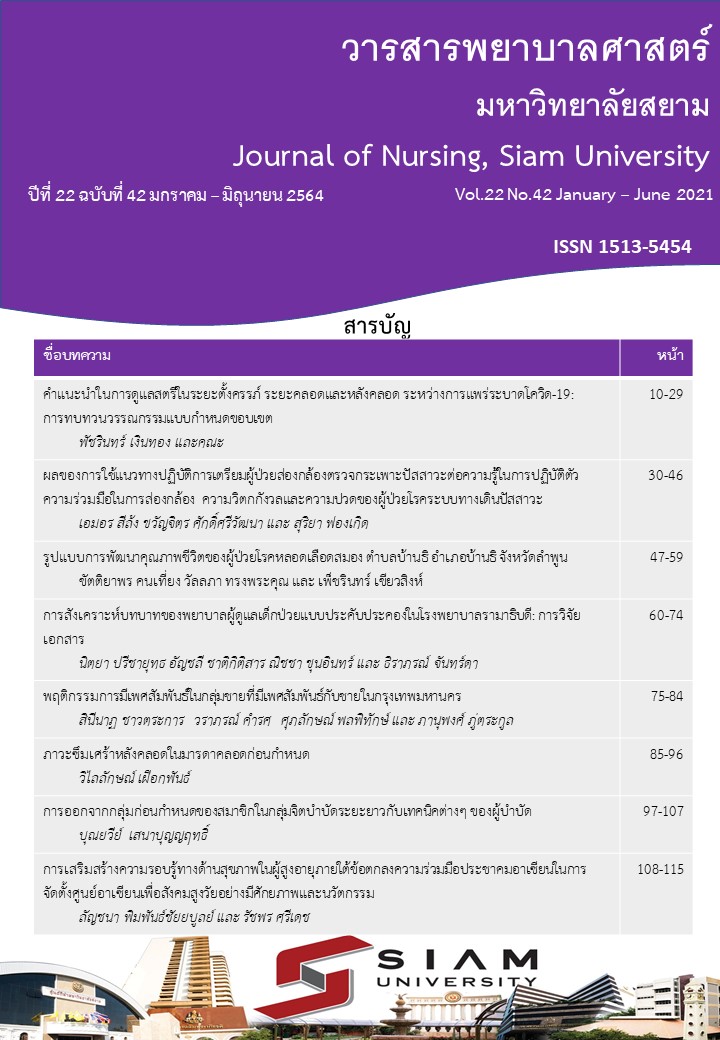Role Synthesis of Pediatric Palliative Nurse in Ramathibodi Hospital : Document Research
Keywords:
Palliative Care, Nursing Role, Pediatric, Palliative Care NurseAbstract
This Article is documentary research to synthesize the role of pediatric palliative care nurse (PPCN) at Ramathibodi hospital. The example was 100 patients who had document of palliative nurse’s notes who was received in hospital more than 48 hours during 1 January 2017 – 31 December 2018. The role of PPCN extends to The concept of Watson’s 10 carative factors and the end-stage patients support of Phra Paisal Visalo. Follow the research: 1) Read the palliative nurse’s notes carefully 2) Find the importance and add Identification code 3) Identify content and find associations for groups 4) Finding correlation for each category. And then synthesis is the role of PPCN. Research result show that the role of PPCN has set this up. 1) Provide health care advice and death according to the level of awareness and the sensitivity of each age 2) Assess the problems, support and strengthen the health of physical, mental, emotional, social and soul for the young patients and families 3) Prepare a joint planning between the multidisciplinary and families 4) Pain management and care for happiness and peace of mind. Reduce fear from being in the hospital or performing procedures 5) Bring about goodness and help patients and families with peaceful mind 6) Coordination 7) Care at the end of palliative care. This research showed that PPCN’s role play an important of the health team approaches covering holistic care to build trust, understanding and acceptance of the patients and families all the way to the end of life to pass away peacefully. And resulting in reduced feelings of loss and grieves.
References
จอนผะจง เพ็งจาด. (2553). การใช้ทฤษฎีการดูแลมนุษย์ของวัตสันในการพยาบาลผู้ป่วยแบบประคับประคอง. วารสารพยาบาลสภากาชาดไทย, 3(1-3), 1-17.
จอนผะจง เพ็งจาด. (2557). บทบาทพยาบาลในการดูแลแบบประคับประคอง. วารสารวิทยาลัยพยาบาลบรมราชชนนี กรุงเทพ, 30(1), 100-109.
จิตสิริ รุ่นใหม่, ดวงกมล มงคลศิลป์, กัญญาวีร์ เกิดมงคล, และสุวพรรณ ตันประภา. (2561). ผลของการใช้เทคนิคการเบี่ยงเบนความสนใจร่วมกับการจัดสภาพแวดล้อมต่อความกลัวการได้รับสารน้ำทางหลอดเลือดดำของผู้ป่วยเด็กวัยก่อนเรียน. วารสารการปฏิบัติการพยาบาลและการผดุงครรภ์ไทย, 5(2), 55-68.
จินตนา อาจสันเที๊ยะ, และรัชณีย์ ป้อมทอง. (2561). บทบาทพยาบาล: กรณีศึกษาการดูแลด้านจิตใจของผู้ดูแลผู้ป่วยระยะท้าย. วารสารพยาบาลทหารบก, 19 (1),1-8.
ดาริน จตุรภัทรพร. (ม.ป.ป.). Common Symtoms in Palliative Care. Patient Care During Last Hours. Retrieved from https://www.rama.mahidol.ac.th/fammed/th/palliativecare/symptoms/doctorpalliative16th
ทิพย์สุดา สำเนียงเสนาะ. (2556). การเผชิญกับภาวะสูญเสียและเศร้าโศก. วารสารวิทยาศาสตร์และเทคโนโลยี, 21(7), 658-667.
นิตยา ปรีชายุทธ. (2560). โครงการ Pediatric Palliative Care เพื่อการดูแลที่ยั่งยืน งานมหกรรมคุณภาพ คณะแพทยศาสตร์ โรงพยาบาลรามาธิบดี.
เบญจวรรณ งามวงศ์วิวัฒน์, ชนานันท์ โพธิ์ขวาง, วิริยา โพธิ์ขวาง-ยุสท์, และพนิดา อาวุธ. (2560). การพยาบาลเด็กป่วยมะเร็งระยะสุดท้ายแบบประคับประคอง : มุมมองในประเด็นสําคัญ. วารสารการพยาบาล การสาธารณสุขและการศึกษา, 18 (3), 27-38.
ปราณี อ่อนศรี. (2557). บทบาทพยาบาลกับการดูแลผู้ป่วยระยะสุดท้ายตามความเชื่อทางศาสนา. วารสารพยาบาลทหารบก, 15(2), 39-43.
ปาริชาติ เพียสุพรรณ์, และสุธีรา พิมพ์รส. (2558). การจัดการกับอาการในผู้ป่วยระยะสุดท้าย. ในประคอง อินทรสมบัติ และสายพิณ เกษมกิจวัฒนา (บรรณาธิการ.), คู่มือพัฒนาทักษะสำหรับพยาบาลในการดูแลผู้ป่วยระยะสุดท้าย (น.159-163.) สภาการพยาบาลและสมาคมพยาบาลแห่งประเทศไทย สำนักงานคณะกรรมการสุขภาพแห่งชาติ.
พระไพศาล วิสาโล. (2557). การช่วยเหลือผู้ป่วยระยะสุดท้ายด้วยวิธีแบบพุทธ. กรุงเทพฯ: สำนักพิมพ์สุภา จำกัด.
รจนา ทองดํา, วราภรณ์ คงสุวรรณ, และกิตติกร นิลมานัต. (2558). การตายอย่างสงบตามมุมมองของพยาบาลไทยมุสลิม. วารสารพยาบาลสงขลานครินทร์, 35(2), 21-34.
วัลภา คุณทรงเกียรติ.(2554).การตายดีตามการรับรู้ของผู้ป่วย.วารสารคณะพยาบาลศาสตร์ มหาวิทยาลัยบูรพา,19(6), 1-12.
สภาการพยาบาลและสมาคมพยาบาลแห่งประเทศไทยในพระราชูปถัมภ์สมเด็จพระศรีนครินทราบรมราชชนนี. (2557). แนวปฏิบัติการพยาบาลทางคลินิกสำหรับผู้ป่วยเด็กระยะสุดท้าย. กรุงเทพมหานคร: จุดทอง.
Akard, T. F., Hendricks-Ferguson, V. L., & Gilmer, M. J. (2019). Pediatric palliative care nursing. Ann Palliat Med, 8(Suppl1), S39-48.
Lichtenberg, F. R. (2017). The impact of biomedical innovation on longevity and health. Nordic Journal of Health Economics, 5, 45-57.
Piaget, J. (1997). The Moral Judgment of the Child. Illinois: Free Press.
Schulman-Green, D., & Shelli Feder. (2018). Integrating Family Caregivers Into Palliative Oncology Care Using The
Self- And Family Management Approach. Seminars in Oncology Nursing, 34(3), 252-263.
Symons-Bradbury, J. (2004). Children's Perceptions of Death: A Piagetian Perspective. (Master of Arts in Community Counselling Psychology). Witwatersrand Johannesburg, Retrieved from https://core.ac.uk/download/pdf/39664068.pdf
Watson J (2005). Caring Science as Sacred Science. Philadelphia: F.A. Davis.
Watson, J. (2008). Nursing : the philosophy and sciencemof caring. the University Press of Colorado: Colorado.
World Health Organization. (2015). WHO Definition of Palliative Care. Retrieved from https://www.who.int/cancer/alliative/en/
Downloads
Published
How to Cite
Issue
Section
License
Content and information published in the Journal of Nursing, Siam University is the comment and responsibility of the authors.
Articles, information, images, etc. published in the Journal of Nursing. Siam University is the copyright of the Journal of Nursing, Siam University. If any person or entity wants to take all or part of it for publication for any purposes, please reference the Journal of Nursing, Siam University.



